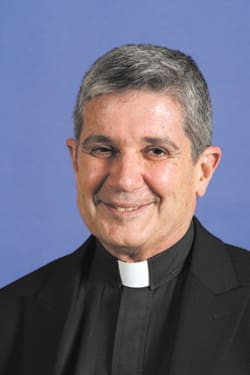A thousand Notre Dames
By MSGR. RICHARD LOPEZ, Commentary | Published September 19, 2019
The eyes of the world were turned toward Paris with the tragic, accidental burning of Notre Dame Cathedral earlier this year. If only the tragedies of the Christians in the Middle East garnered the same level of attention.
In Syria, the Deir ez-Zor Armenian Genocide Memorial Church was built on the site where thousands of men, women and children were murdered, raped, starved and beaten by Turks in their horrific holocaust of Christians around the time of World War I. Isis blew up the church and the remains of thousands of martyrs. Yet after the attack in September of 2014, no bells were rung for that sacred spot in Syria, as they were for Notre Dame.
The Dair Mar Elia Monastery, Iraq’s oldest, was constructed by Assyrian monks in the late sixth century. In the 18th century, 130 monks had their throats slit by Persian invaders for refusing to convert to Islam. Isis destroyed the monastery in 2014 with little coverage in the media in the west.

Msgr. Richard J. Lopez
Human Rights Watch has reported that at least 37 churches in Egypt have been burned to the ground by Islamists. Let us encourage a movement in our schools to raise funds to support the Christian children of Egypt, who have seen their places of worship ruined not by accident, but by religious hatred.
The Monastery and Shrine of St. Elian in Syria, which was 900 years older than Notre Dame, was also blown up by Isis. St. Elian, in 284 AD, refused to give up Christ and was martyred. His shrine and bones were desecrated, while contemporary Christians were being added to the rolls of the martyrs in Syria, Iraq, Pakistan, Egypt and Nigeria. When the nearby secular ruins of Palmyra were blown up by fanatics, it was reported in our press, but not many can speak of the sacrilege done to the Monastery and Shrine of St. Elian and hundreds of other sacred spots.
Mass has been celebrated in Mosul, Iraq since virtually the time of the Apostles. All the churches of Mosul have been destroyed. St. Markourkas, five hundred years older than Notre Dame, was blown up and a nearby Christian cemetery bulldozed.
The ancient monasteries of the Middle East have been centers of scholarship, pilgrimage and refuge for the persecuted faithful for 1,700 years. So many of these shrines of our heritage and theirs have been destroyed and desecrated. For Americans, it would be as if the National Archives, the tomb of the Unknown Soldier or the Lincoln memorial were blown up. The monasteries and churches in the Middle East are sacred places for all Christians.
One local Iraqi Christian refugee lamented that his people have defended these spots for 1,600 years—“We owe the next generation an explanation for our lack of responding, as our historical treasure is phased out of the region. Is this our best response to protect Christianity’s physical roots?”
Jeremy Hunt, the British foreign secretary, offers an insight into indifference. He says that “political correctness” contributes to it and caters to the terrorists trying to eliminate Christianity. To the Christians of Atlanta, I quote scripture: “Is it nothing to you all who pass by?” (Lam 1:12).
If it is something to you, please contact Aid to the Church in Need or Catholic Near East Welfare Association and support their efforts to help persecuted Christians.
Msgr. Richard Lopez served for many years as a teacher at St. Pius X High School, Atlanta.